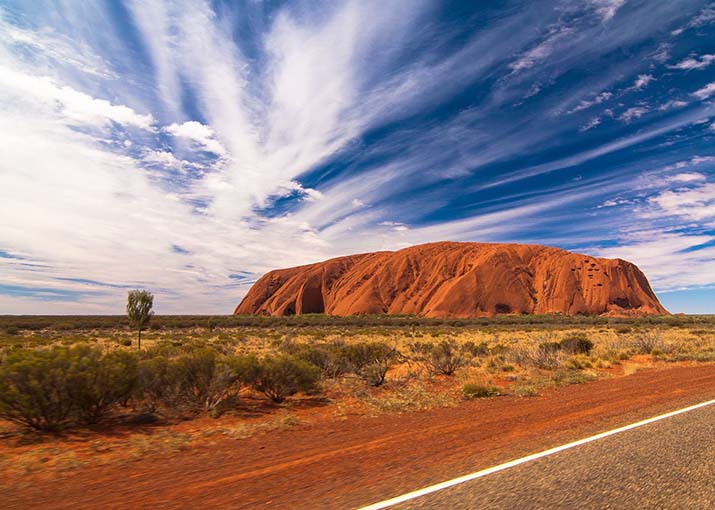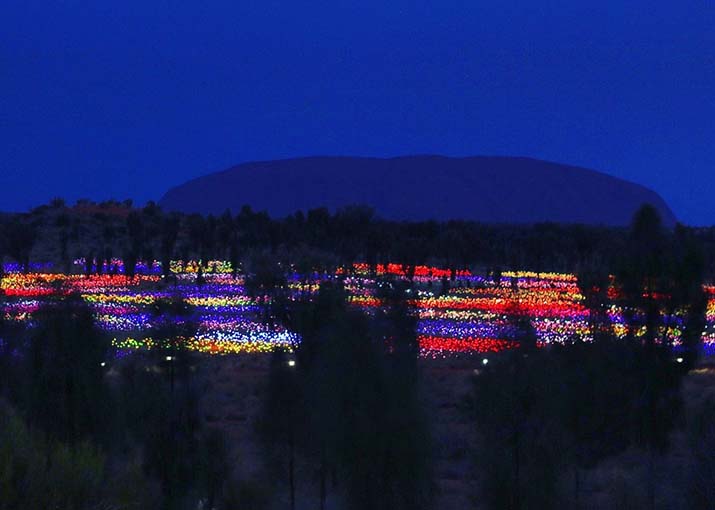Australia’s charm extends far beyond its urban hubs, beckoning adventurers to explore the heart of the continent. The Red Centre Way, winding through Alice Springs and Uluru, promises an immersive journey through the raw beauty of the Australian outback—a fusion of indigenous culture, breathtaking natural wonders, and the vibrant hues of the red desert.
Arrival in Alice Springs:
Touch down in Alice Springs, greeted by the warm embrace of its dry air. The town, a gateway to the Red Centre, unveils a tapestry woven with history and culture.
Commence your exploration at the Alice Springs Telegraph Station, a relic from the 19th century telegraph era. Wander through preserved buildings, immersing yourself in the tales of global communication. Afternoon adventures include the Royal Flying Doctor Service and the School of the Air, offering insights into remote Outback life.As I stand before the historic Alice Springs Telegraph Station, the gateway to my outback exploration, I’m transported back in time to the 19th century telegraph era. The weathered sandstone buildings echo with the whispers of bygone messages that once traversed vast distances, connecting distant corners of the world. Eager to absorb the tales of global communication etched into these preserved structures, I step into the past.
Wandering through the station’s well-maintained grounds, I find myself immersed in the ambiance of a bygone era. The telegraph office, living quarters, and other preserved buildings reveal the challenges and triumphs of maintaining this crucial communication link in the heart of Australia. The creaking floorboards and vintage equipment transport me to a time when each transmission held the weight of importance and urgency.
As the afternoon sun bathes the landscape in a warm glow, I venture beyond the telegraph station to explore two other integral facets of outback life. My next stop is the Royal Flying Doctor Service, an icon of Australia’s vast and remote landscapes. Here, I learn about the life-saving medical services that traverse the skies to reach those in need, bringing healthcare to the farthest corners of the Outback. The tales of resilience and resourcefulness resonate, emphasizing the spirit of community in the face of geographic isolation.
Continuing my journey into the unique challenges of remote education, I visit the School of the Air. The innovative concept of delivering lessons to children spread across vast distances captures my curiosity. Interactive displays and insightful presentations provide a glimpse into the daily lives of students and teachers who bridge the gap through the airwaves. It’s a testament to the adaptability of Outback communities, where education transcends the boundaries of distance.
As the day unfolds, I find myself not only exploring historical relics and technological marvels but also connecting with the spirit of resilience that defines life in the Outback. These afternoon adventures have set the stage for the broader journey ahead, where each step will unveil more layers of the Outback’s rich tapestry and the remarkable stories it holds.
West MacDonnell Ranges:
Embark on a day trip to the West MacDonnell Ranges, a captivating mountain range west of Alice Springs. Traverse iconic sites like Simpsons Gap and Standley Chasm, indulging in short hikes to embrace the rugged beauty and biodiversity.
As the day wanes, witness a mesmerizing sunset at Tjoritja/West MacDonnell National Park, where changing hues over ancient landscapes create a canvas of tranquility.
East MacDonnell Ranges:
Continue the exploration to the East MacDonnell Ranges, discovering treasures like Trephina Gorge and Emily Gap. These sites, adorned with indigenous rock art, share the Dreamtime stories embedded in the land.

A visit to the Arltunga Historical Reserve adds a historical dimension, unraveling the challenges faced by early pioneers in the unforgiving Outback.Leaving the echoes of the telegraph era behind, I set my sights on the Arltunga Historical Reserve, eager to delve deeper into the challenges faced by early pioneers in the rugged embrace of the Outback. The journey to Arltunga unfolds as a dusty trail, mirroring the arduous paths tread by those who sought fortune and adventure in this unforgiving land.
As I arrive at the historical reserve, the atmosphere is thick with tales of resilience and determination. The preserved ruins and artifacts transport me to the late 19th century, a time when intrepid prospectors flocked to the area in search of gold. Walking through the remains of the once-thriving mining town, I can almost hear the sounds of pickaxes against rock and the murmurs of dreams being chased.
The humble cottages, now weathered by time, stand testament to the harsh conditions faced by these early settlers. The relentless sun, the scarcity of water, and the isolation of the Outback presented formidable challenges. Yet, the pioneers of Arltunga pressed on, driven by the promise of prosperity and the spirit of adventure.
The historical reserve offers a glimpse into the daily lives of those who called Arltunga home. Mining equipment, household items, and personal artifacts paint a vivid picture of the resilience required to carve out a livelihood in this harsh environment. I find myself contemplating the sacrifices made and the stories untold by those who paved the way for the Outback’s future.
The landscape surrounding Arltunga is both unforgiving and awe-inspiring. The rocky terrain, punctuated by the remnants of mining endeavors, speaks of a time when the pursuit of wealth clashed with the harsh realities of nature. I take a moment to absorb the solitude, reflecting on the contrast between the aspirations of the past and the serene, untouched beauty of the present.
As the sun begins to dip below the horizon, casting a warm glow over the historical reserve, I leave Arltunga with a profound appreciation for the indomitable spirit of the early pioneers. Their stories, etched into the red earth and weathered structures, linger in the Outback breeze, reminding me that every step in this vast and storied land carries the weight of history and the promise of discovery.
Journey to Kings Canyon:
Bid adieu to Alice Springs and set course for Kings Canyon, a geological marvel in Watarrka National Park. The drive unveils the vastness of the Outback, with red plains stretching to the horizon. Arriving at Kings Canyon Resort, prepare for an unforgettable experience.
In the evening, a stroll to the canyon rim reveals a breathtaking sunset, casting warm hues over ancient sandstone walls—an illustration of the Red Centre’s enchantment.
Kings Canyon Rim Walk:
Embark on the iconic Kings Canyon Rim Walk, a challenging trek offering rewarding views of towering cliffs and the lush Garden of Eden. The afternoon unfolds at Kings Creek Station, a working cattle and camel station providing a taste of Outback life.
Journey to Uluru:

Hit the road again, bound for Uluru, the crown jewel of the Red Centre. The drive offers uninterrupted views of the desert, occasionally interrupted by iconic red sand dunes. As Uluru emerges on the horizon, anticipation builds, capturing your imagination with the sheer enormity of this sacred monolith.
Upon arrival, settle into your chosen accommodation, whether a luxury resort or a cozy campsite under the starlit Outback sky. Spend the evening at the Uluru-Kata Tjuta Cultural Centre, deepening your understanding of this UNESCO World Heritage site.
Uluru Base Walk and Field of Light:
Begin your day with the awe-inspiring Uluru Base Walk, a 10-kilometer circuit providing insights into the cultural and geological features of Uluru. Sacred sites and rock art narrate the stories of the Anangu people, adding layers of significance to your experience.
In the late afternoon, prepare for a magical encounter at the Field of Light, an art installation by Bruce Munro. As the sun sets, the desert comes alive with thousands of illuminated stems, creating a surreal and enchanting landscape where art and nature converge.With the day’s historical explorations behind me, I eagerly prepare for a truly enchanting experience awaiting me in the late afternoon—the Field of Light. As the sun begins its descent, casting a warm palette of hues over the desert landscape, I make my way to this mesmerizing art installation by Bruce Munro.
As I approach the Field of Light, anticipation courses through me. The vast expanse is transformed into a surreal dreamscape as thousands of illuminated stems come into view, creating a breathtaking fusion of art and nature. The gentle breeze carries a sense of anticipation, mirroring my own excitement for the magical encounter that awaits.
As the sun dips below the horizon, the first hints of twilight cast long shadows across the desert floor. It’s a perfect prelude to the main event. Slowly, the stems begin to glow, casting a soft and ethereal light that seems to dance with the rhythm of the desert wind. The desert, once bathed in natural daylight, is now adorned with a tapestry of vibrant colors, as if stars have descended to Earth.
Walking through the Field of Light feels like stepping into an otherworldly realm. The illuminated stems create a sense of wonder and awe, their vibrant colors reflecting off the ancient landscape. The juxtaposition of the contemporary art installation against the timeless beauty of the desert creates a harmony that is both surreal and harmonious.
I find a quiet spot to sit and absorb the enchantment that surrounds me. The play of light and shadow, the silence interrupted only by the soft rustle of the wind, creates a meditative atmosphere. It’s a moment where time seems to stand still, allowing me to immerse myself fully in the magic of this ephemeral masterpiece.

As darkness fully descends, the Field of Light becomes a celestial canvas, inviting contemplation and reflection. The stars above twinkle in harmony with the illuminated stems below, blurring the lines between the earthly and the cosmic. It’s a reminder that art, like nature, has the power to transcend boundaries and evoke emotions that linger long after the experience has ended.
Leaving the Field of Light, I carry with me the memory of this magical encounter—an extraordinary blend of artistic expression and the raw beauty of the desert. As I retire for the night, the images of illuminated stems dancing in the darkness continue to flicker in my mind, leaving an indelible mark on my journey through the heart of the Outback.
Kata Tjuta and Valley of the Winds:
Dedicate a day to exploring Kata Tjuta, a group of domed rock formations west of Uluru. Embark on the Valley of the Winds hike, offering stunning views between massive red rocks. In the afternoon, visit Walpa Gorge, a serene gorge between towering domes, providing a mesmerizing backdrop against the vivid Outback colors.
Sunrise at Uluru and Cultural Experiences:
Set your alarm early to witness the sunrise at Uluru, transforming the rock into a glowing monolith. As sunlight bathes the desert landscape, grasp the profound significance of this sacred site for the Anangu people.
Engage in cultural experiences led by local Indigenous guides, delving into Dreamtime stories, traditional bush tucker, and the art of dot painting. These interactions forge a deeper connection to the land and its custodians, offering a profound and enriching experience.
As your unforgettable journey through the Red Centre concludes, take a moment to reflect on the vastness, beauty, and cultural richness of the Australian outback. Bid farewell to this extraordinary region, carrying the spirit of the Red Centre with you. The memories of your outback odyssey will remain etched in your heart as you board your flight home, leaving the echoes of the ancient land resonating within you.


